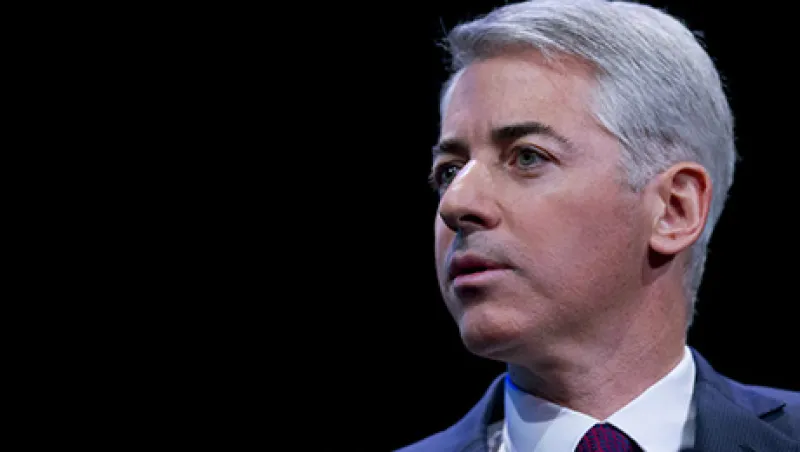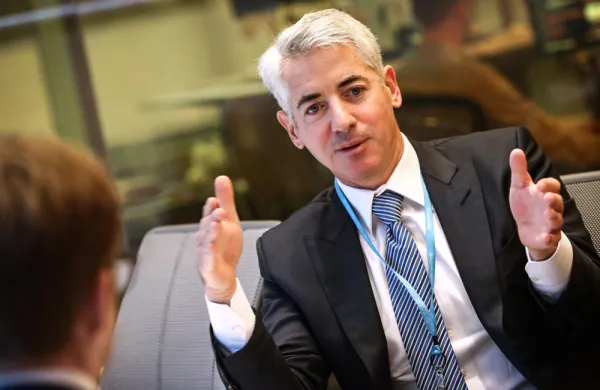For hedge fund manager Bill Ackman, a publicly traded permanent capital vehicle must have been eminently desirable. And, as of Monday, when Pershing Square Holdings went public on the Euronext Amsterdam, Ackman has one.
It is clear why retail investors and others might want a piece of the Ackman mojo: His New York–based Pershing Square limited partnership has delivered an annualized return of more than 20 percent since its 2004 inception. What is less clear, however, is whether the IPO, which raised roughly $2.7 billion, is good news for investors in the activist manager’s existing hedge fund vehicles, which have $9.9 billion in assets, as of June 30, mostly in Pershing Square, Pershing Square II and the offshore Pershing Square International.
If Pershing Square investors want to redeem, it will take them two years to get all their money back. In the meantime, according to the terms of the IPO prospectus, they could end up effectively subsidizing the lower-fee-paying investors in Pershing Square Holdings.
Unlike many hedge fund managers today, Ackman is not content to hit investment singles and doubles. He is more of a “Go big, or go home” kind of guy. Sometimes, such as when he took the real estate holding company General Growth Properties into and out of bankruptcy, his trades can be phenomenally successful. Other times, as in his 2009 shareholder activism campaign against retailer Target, they flame out horribly. All this makes for good copy, and Ackman woos the press as adeptly as he wields a PowerPoint presentation. But whereas his overall track record is strong, his strategy can make for a white-knuckle ride for investors.
Exactly how hairy that ride can get has been obvious since Ackman’s notorious short of Herbalife (HLF). Much has been written and said about Ackman and HLF, but for anyone who has somehow been oblivious over the past two years (yep, it’s been going on that long) or is in need of a quick refresher, the story is this: In December 2012 Ackman busted out a 342-slide PowerPoint presentation arguing that the Cayman Islands–domiciled herbal supplement seller was nothing more then a Ponzi scheme. HLF, which operates through a director-selling approach not dissimilar from, say, Avon or Tupperware, fought back vigorously. Ackman announced he had a massive, 20 million-share–plus short on the company. Other fund managers, in particular Dan Loeb and Carl Icahn, jumped on the other side of the trade. The result has been an entertaining battle, including a live CNBC shouting match between Ackman and Icahn and one of the most awkward bro hugs in human history.
For Pershing Square investors, the ride has been less fun. Herbalife shares have careened from $26 to a high of more than $80 to trading in the $45 range today. Interestingly, annualized returns of Pershing Square have remained strong; the fund is up 31.83 percent year-to-date and returned 9.3 percent in 2013, owing to successful bets elsewhere. Nonetheless, the Herbalife trade made some investors nervous, and Ackman experienced some redemptions.
According to the prospectus, Pershing Square Holdings currently has, and is expected to have going forward, very similar if not identical exposures to Pershing Square. But investors in Ackman’s main fund, however, can withdraw only one eighth of their assets per quarter. So, investors who redeemed from Pershing Square in September 2014 would only be able to get all of their money back by September 2016.
What the publicly traded closed-end fund does is allow Ackman the flexibility to have the courage of his convictions without having to worry that investors will get cold feet. Pershing Square Holdings’ $3.07 billion in assets (which includes money that existing investors rolled into the new vehicle) is his to invest as he pleases. Investors in the holding company who don’t like what Ackman is doing can sell their shares; they have daily liquidity.
Pershing Square Holdings also offers better fees than most hedge funds, including Pershing Square. According to the prospectus, investors in Pershing Square Holdings will pay a 1.5 percent management fee and a performance fee of up to 16 percent. Although Pershing Square’s limited partners also pay a 1.5 percent management fee, they pay a 20 percent performance fee. What might really stick in their craw is that the more limited-partner money Pershing Square has, the less the holding company investors pay.
Here is how it works. Under the terms of the deal, Pershing Square Holdings gets an “additional reduction” in fees, which is based off how much the investment manager — that is, the parent money management firm — makes off the other funds it manages. So, if Pershing Square Holdings makes up 100 percent of the funds Ackman is managing, it pays a 16 percent performance fee. If it makes up 20 percent or less of the total assets, the holding company investors pay no performance fee. Right before the IPO Pershing Square Holdings made up 23.5 percent of the aggregate fee-paying assets, though that number was expected to increase as a result of the IPO.
The IPO document helpfully provides an example of what a fee deduction might look like. Assuming $9 billion in other fee-paying assets, which is what the firm had as of the end of June, and a net return before performance fee of 26 percent, the holding company investors would receive an additional fee reduction of $94 million.
Pershing Square Holdings is relying on the same investment team, the same research resources, the same office space and Bloomberg terminals as the rest of Pershing Square’s funds. So the locked-up investor assets — as opposed to the permanent capital of the IPO — are effectively subsidizing the publicly traded shareholders, who can sell their stock at any time. Pershing Square International investors were offered the option to roll over the assets into the holding company.
Pershing Square Holdings, then, is just one example of how extremely frustrating the hedge fund fee issue is for long-term asset owners. If I am a provider of long-term capital, I should be paid a premium for that. Instead, increasingly, the benefit of long-term money comes at a cost to the investors providing it. The same is true of ’40 Act vehicles, as hedge fund firms are charging a 2 percent management fee and 20 percent performance fee for their main funds while offering a discounted liquid ’40 Act version. The frustration is all the greater when the long-term asset owners are large institutional investors, such as pensions and sovereign wealth funds, which are giving millions, and sometimes even billions, of dollars to one manager.
Although Pershing Square Holdings’ shares dropped after their debut, I actually think the publicly traded model makes a great deal of sense for Ackman. He has said he hopes to mimic Warren Buffett and Berkshire Hathaway. And its hardly a surprise that he is looking to the Sage of Omaha for inspiration and not, say, Phil Falcone — another controversial hedge fund manager who has found the holding company to be a viable structure for his ambition. (Although in Falcone’s case, he had little or no other option.) And Ackman has done well by Pershing Square limited partners. But aside from the tax benefits, hedge fund investors must be scratching their heads and wondering just when they became the suckers at the card table with their one eighth redemption schedule and 20 percent performance fee.
Follow Imogen Rose-Smith on Twitter at @imogennyc.






